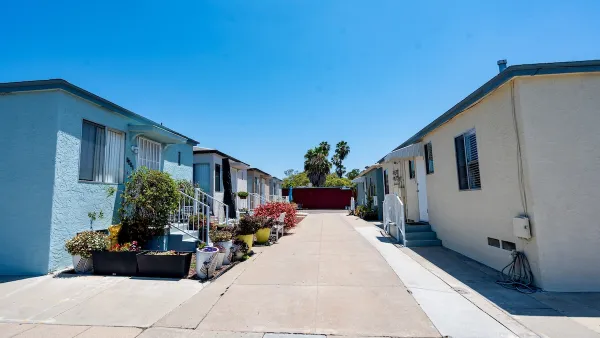Prospect Newtown, in Longmont, CO, has seamlessly integrated affordable housing by creating a host of accessory dwelling units (ADUs). The ADUs are perfectly blended within the town overall—and actually help contribute to the development’s success.

Set on the 80-acre site of his family’s former tree farm only a 10-minute drive from Boulder, Prospect Newtown was conceived of by developer Kiki Wallace in the mid-1990s. Attracted to New Urbanism’s tenets of walkable, livable communities, Wallace decided to create a development based on these ideals.
Wallace hired renown New Urbanist architects Duany Plater-Zyberk (DPZ) to carry out his vision. Over the last twenty years, and throughout multiple building phases, Prospect has become a thriving new kind of suburban community. Kids run along sidewalks on narrow tree-lined streets, a town center beckons locals with shops, restaurants, and offices, along with a community park, and a mix of home types—including townhomes, detached houses, live/work spaces, and lofts above retail—attract residents with a variety of architectural styles.
ADUs are a vital component of this plan. Originally, city ordinances required that 10% of new housing needed to be affordable, with no specifics to how this should be done. As a result, Wallace and DPZ decided that ADUs would fill this role. Set above detached garages or behind homes, and generally around 500-650 square feet, these units rent for around $1,000 and are eminently popular with renters and homeowners alike. “By virtue of their location, they act as naturally occurring affordable housing,” says Wallace. “There’s no need to mandate or regulate them.” There are currently around 325 townhomes, condos, lofts, and houses in Prospect—and some 150 additional ADUs.
First and foremost, the planners knew that ADUs had to appeal to homeowners to make them successful. To ensure that “homeowners don’t feel threatened and that renters have privacy” as Wallace describes, thoughtful design included creating separate entrances, making sure that ADUs’ windows didn’t look into the backyard, and placing them behind homes so they feel distinct from the main residence. Though initially the first owners of ADUs all said they wouldn’t rent them out, within six months, all of the first ADUs were completely rented since as Wallace says, “There’s no invasion of privacy, and they bring in subsidies for the landlord.”
FULL STORY: Prospect's Affordable Accessory Dwelling Units

Analysis: Cybertruck Fatality Rate Far Exceeds That of Ford Pinto
The Tesla Cybertruck was recalled seven times last year.

National Parks Layoffs Will Cause Communities to Lose Billions
Thousands of essential park workers were laid off this week, just before the busy spring break season.

Retro-silient?: America’s First “Eco-burb,” The Woodlands Turns 50
A master-planned community north of Houston offers lessons on green infrastructure and resilient design, but falls short of its founder’s lofty affordability and walkability goals.

Test News Post 1
This is a summary

Analysis: Cybertruck Fatality Rate Far Exceeds That of Ford Pinto
The Tesla Cybertruck was recalled seven times last year.

Test News Headline 46
Test for the image on the front page.
Urban Design for Planners 1: Software Tools
This six-course series explores essential urban design concepts using open source software and equips planners with the tools they need to participate fully in the urban design process.
Planning for Universal Design
Learn the tools for implementing Universal Design in planning regulations.
EMC Planning Group, Inc.
Planetizen
Planetizen
Mpact (formerly Rail~Volution)
Great Falls Development Authority, Inc.
HUDs Office of Policy Development and Research
NYU Wagner Graduate School of Public Service



























